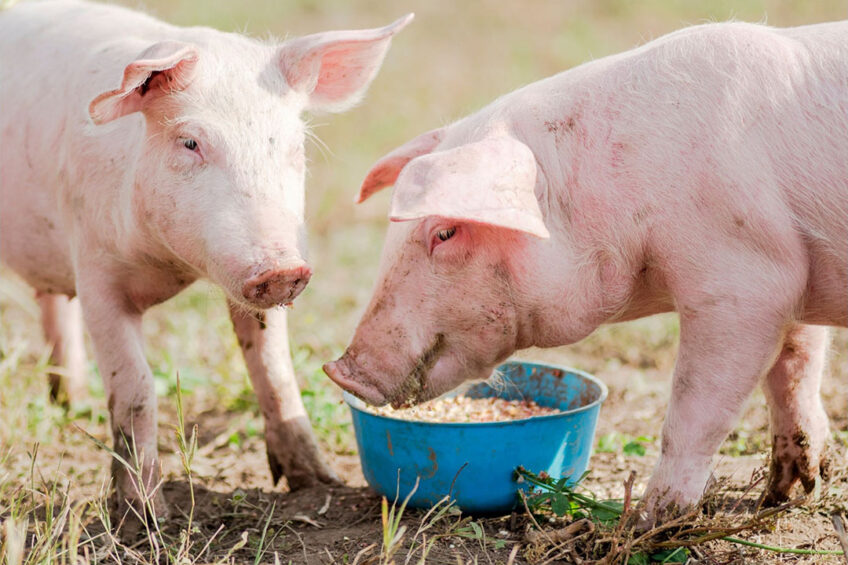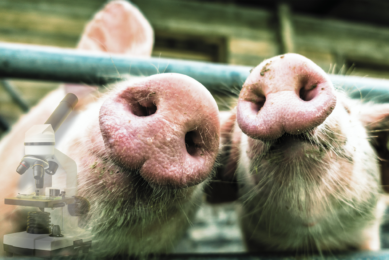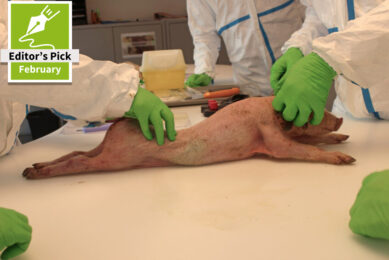Intestinal disease will cost you when feed is expensive

Over the past years, feed costs have made up for about two-thirds of the total cost of production. With the current feed prices, this has risen to about three quarters of the total cost of production! What can we do to reduce the impact of the current feed prices on the profitability of pork?
Part of the Gut Health 2022 Special
There is no doubt that intestinal health is one of the most important drivers for an economical and sustainable production of pigs, especially with the feed price being the highest cost of production. Healthy guts with a healthy microbiome, digest the feed in the most optimum way, efficiently converting feed into pork. Gut bacterial infections have the highest negative impact on average daily gain of pigs, when compared to poor housing conditions, LPS challenge, mycotoxins parasitic infections and respiratory diseases. One of the most common bacterial diseases in pig production, is ileitis. Ileitis is caused by an intracellular living bacterium, Lawsonia intracellularis, present in almost every pig farm in the world, which multiplies in the intestinal cells, the so-called enterocytes, using them as a breeding chamber. The bacterium is spread worldwide and about 80% of the slaughter pigs have been shown to be infected with this disease. Recently more and more are known about the interaction of this bacterium with the intestinal cells, and its effect on zootechnical production parameters such as average daily gain and feed conversion.
How ileitis influences feed efficiency
Researchers form the USA have discovered mechanisms in the way that this bacterium influences feed efficacy. Infections with L. intracellularis result in less enzyme production (sucrase-isomaltase) in the intestines, resulting in a lowered average daily gain and an increase in the Feed Conversion Ratio (FCR) in those pigs. The effect of lower enzyme production is observed over the full surface of the intestinal lining, from the crypt to the villous tip. These effects were not observed in the pigs vaccinated with a live attenuated Lawsonia given orally which resulted in a better feed efficiency in the vaccinated pigs when compared to unvaccinated pigs. In the same experiment the improvements in performance were seen together with a lowered shedding of L. intracellularis three weeks after challenge.
Ileitis and microbiome
With recent techniques on the analysis of the gut microbiome, the natural microorganisms critical for health, more and more is known about the impact of Lawsonia on the balance of the microbiome. Most is known from analysis of laboratory challenge studies, which have shown that Lawsonia disturbs the microbiome, making it more vulnerable for other pathogens, like Salmonella. Oral vaccination with a live attenuated Lawsonia has proven to counteract these negative effects, by shifting the microbiome towards a beneficial microflora that produces for instance butyrate, which reduces the virulence and shedding of S. Typhimurium. Very recently, this has been confirmed by independent researchers of the Hannover University, Germany. Under field conditions they have shown differences in microbiome in oral live vaccinated and unvaccinated pigs. These effects were stronger for unvaccinated pigs showing moderate to soft stools. Vaccination led to an overall enrichment of the bacterial species Clostridiales, which is a family of fermenting bacteria producing beneficial short chain fatty acids like butyrate.
Meaning of ileitis in day-to-day pig production
Most of the science regarding Lawsonia is known from experimental challenge studies. These challenge studies provide us lots of insights on the disease and how the bacterium interacts with the immune system and the microbiome. However, it’s hard to translate this into a day-to-day pig production. Challenge studies are done with a high concentration of Lawsonia with the amount of about 1 billion bacteria. To give you an idea of the size of this number, 1 billion seconds equals the period of about 31 years and 8 months! Field infections in commercial pig production are in general over a thousand-fold lower, leading in most cases to subclinical infections. The disease is there but not quite so easy to see from the outside. To evaluate the effect of oral live vaccination to protect the pigs against ileitis, a retrospective analysis was performed, including 38 case studies under field conditions, not including challenge studies. This analysis showed an average improvement of average daily gain of 37 grams, lowering FCR by 0.08 and lowering mortality by 0.78%. Under current market conditions in western Europe this would represent a total economic value €4.60 per vaccinated pig (Table 1), close to 5 cents per kg pork produced. Especially the impact of improved FCR is quite important, accounting for €3.04/pig for two third of the total economic impact of this disease. Even in conditions where FCR is not routinely monitored, we know from research that an improvement of FCR and ADG is closely correlated to each other. An improvement in ADG will also have a benefit of a more favourable FCR.
These data show the importance of this widespread disease and the value that is lost when you do not control this infection. Nowadays, with the current high feed prices, control of ileitis using vaccination is more important than ever. There is more to gain!
References available on request.







